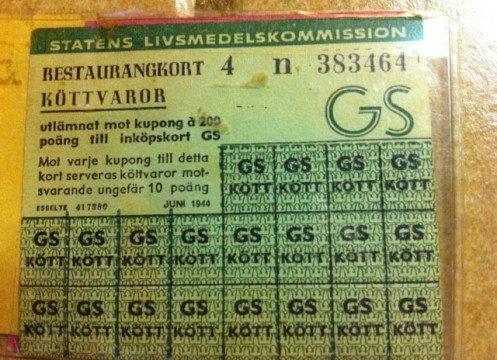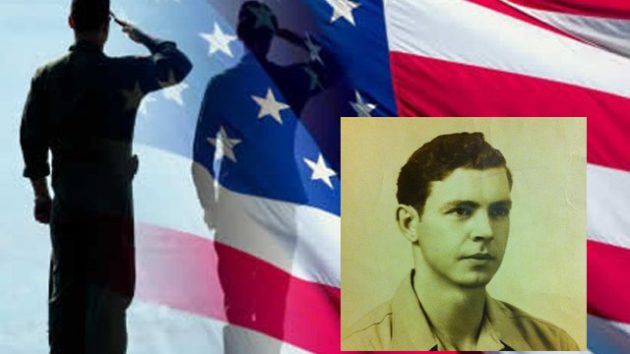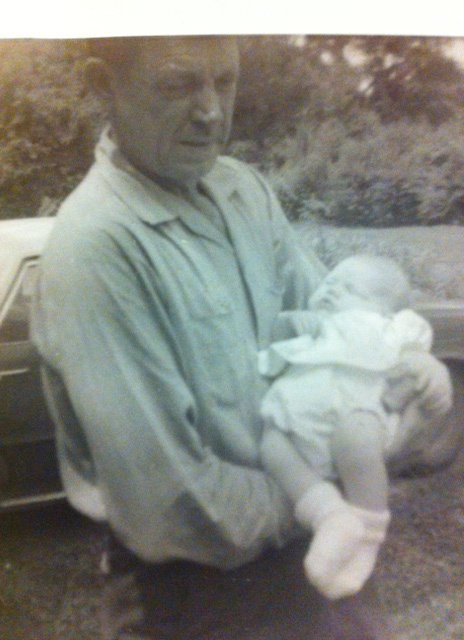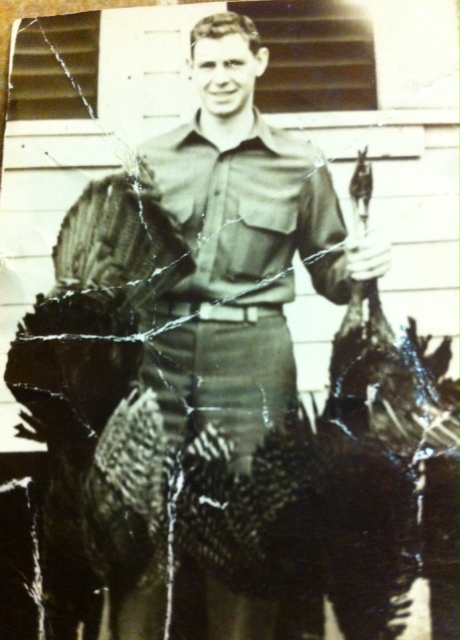Memorial Day 2014: Honoring My Daddy

Insignia for the Third Army, Seventy-first Division
On this Memorial Day, I would like to feature my father, Michael Louis Schneider, Jr. (October 31, 1918 – May 10, 1980), who served in the Third Army, Seventy-first Division, from 1943 to 1946. Michael L. Schneider, Jr., circa 1943. He was around 25 years old at the time. I think he was really handsome. Daddy did not tell me much about his time serving in World War II, but he was obviously proud when he said his division was under General George Patton. He also told me that he had a date once with actress Jane Russell. I later learned that Dwight Eisenhower’s son also served in the 71st. I have my daddy’s army yearbook, sent to him from the US War Department around 1947.
I have the book and the original package in which it was sent. “3225 N. Miro Street” is the New Orleans address where my father grew up. My father, in a photo taken of him in Mississippi in 1936 (he was 18 years old); his army yearbook, and the original package in which the yearbook was mailed to him from the US War Department. The yearbook is well done and details the 71st’s movements well. Since it is easier for me to reproduce, here is the Wikipedia summary of the 71st’s combat chronicle:
The 71st Infantry Division arrived at Le Havre, France, 6 February 1945, and trained at Camp Old Gold with headquarters at Limesy. The division moved east, relieved the 100th Infantry Division at Ratswiller and saw its first action on 11 March 1945. Their ouster of the Germans from France began 15 March. The division moved through outer belts of the Siegfried Line, captured Pirmasens, 21 March, and crossed the Rhine at Oppenheim, 30 March. The 71st continued the advance, taking Coburg without resistance, cutting the Munich-Berlin autobahn, 13 April, and capturing Bayreuth after fierce opposition on 16 April. Moving south, the Division destroyed Schönfeld, 18 April, took Rosenberg, crossed the Naab River at Kallmünz on 24 April and crossed the Danube on 26 April. Regensburg fell on the next day and Straubing on 28 April. As resistance crumbled, the division crossed the Isar on 29 April and entered Austria, 2 May.
Participated in the liberation of concentration camps including one in Austria called Gunskirchen Lager on 4 May. A pamphlet was produced by the US Army after they liberated the camp, called “The Seventy-First came to Gunskirchen Lager.” The book recounts in detail, and with very graphic photos, the tragedy they found in the camp. The complete booklet is available for free on-line.
The 71st organized and occupied defensive positions along the Enns River and contacted Russian forces east of Linz, 8 May, the day before hostilities ceased,having gone further east than any other U.S. Army unit. The division was assigned occupational duties until it left for home and inactivation 1 March 1946.
During the last several weeks of the war, the 761st Tank Battalion, an African-American unit that earned a high reputation for its effectiveness in combat, was attached to the 71st Division and fought with it. The 71st Division is also the formation in which Lt. John D. Eisenhower, General Dwight Eisenhower‘s son, served. [Emphasis added.]
Daddy kept all of the above details to himself. He did tell me that he was a master chef in his army division. He also talked of not having water to use to shave and having to do so using hot coffee.
(An amazing aside: The father of one of the faculty members at the high school where I teach was a cook with the Third Army, Seventieth Division. I learned from him that he and my father were across the Rhine River in France at the same time.)
Prior to its deployment to Europe, the 71st was in Fort Benning, Georgia. I have a photo of my father in which he is holding turkeys from a hunt with the general of the parachute school.
On the back of the photo, my daddy wrote, “These are wild turkeys that were killed by the general of the parachute skool (sp.) during a hunting trip in ‘Georgia.’”
Explanation of the turkey hunt photo, written by my father. I loved his manuscript. His formal education stopped with eighth grade and some trade school, but he mastered penmanship. Daddy died when I was twelve. He was 61 years old; his smoking and drinking had taken their toll and led to both cirrhosis of the liver and lung cancer. My nanny (his cousin, Mercedes Stone, for whom I am named and who helped raise me) kept the wallet my father brought home with him from World War II. Once she died in 1992, my aunt Louise (my father’s younger sister) found the wallet with a note in it, written to me. My nanny earmarked the wallet to be passed on to me. It contained an ID card written in his hand, three ration coupons written in some Germanic language, two addresses (one for his brother, Walter, who was also a soldier), and a one-cent postage stamp attached to a piece of paper that had “gossip sinks ships” written on it. My father’s wallet that he carried in World War II , and assorted contents.
My father’s wallet that he carried in World War II , and assorted contents.  My father’s ID card, written in his beautiful handwriting. The emergency contact was for his aunt, Mrs. W. (William) (Annie Schneider) Stone. His mother died in 1922 from childbirth complications when he was not yet four. His aunt was a widow, and she and her brother (my grandfather, Michael Schneider, Sr.) combined their households.
My father’s ID card, written in his beautiful handwriting. The emergency contact was for his aunt, Mrs. W. (William) (Annie Schneider) Stone. His mother died in 1922 from childbirth complications when he was not yet four. His aunt was a widow, and she and her brother (my grandfather, Michael Schneider, Sr.) combined their households.  Restaurant ration coupon dated June 1944. One of three that my father brought home in 1946 from Europe. And with that, I conclude my “show and tell” of my daddy’s serving his country in World War II. I have one more photo to offer, the only one I own of both my father and me. It was taken on August 8, 1967. I was eight days old: My daddy holding me when I was five days old. I loved my daddy and am pleased to have been able to offer my readers this posthumous tribute. Happy Memorial Day to all.
Restaurant ration coupon dated June 1944. One of three that my father brought home in 1946 from Europe. And with that, I conclude my “show and tell” of my daddy’s serving his country in World War II. I have one more photo to offer, the only one I own of both my father and me. It was taken on August 8, 1967. I was eight days old: My daddy holding me when I was five days old. I loved my daddy and am pleased to have been able to offer my readers this posthumous tribute. Happy Memorial Day to all.






